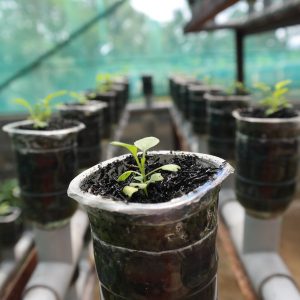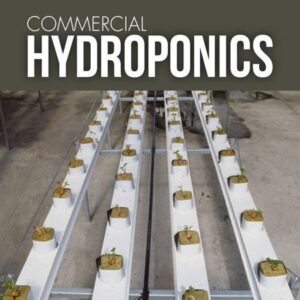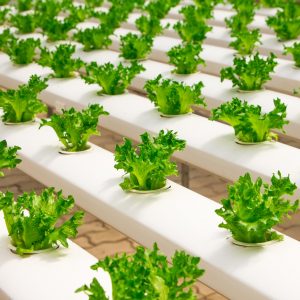 COURSE STRUCTURE
COURSE STRUCTURE
There are ten lessons as follows:
- Introduction
- How a Plant Grows
- Hydroponic Systems
- Nutrition & Nutrition management
- Plant Culture
- Hydroponic Vegetable Production
- Hydroponic Cut Flower Production
- Solid Media vs Nutrient Film
- Greenhouse Operation & Management
- Special Assignment
COURSE AIMS
On successful completion of the course you should be able to do the following:
- Explain different hydroponic systems.
- Select appropriate media for specified hydroponic crops.
- escribe the equipment used in hydroponic systems.
- Determine the management of nutrition in hydroponic systems.
- Explain the management of a greenhouse in the production of a hydroponic crop.
- Plan the establishment of hydroponic facility to satisfy specified criteria, both commercial and cultural.
- Develop a management plan for a hydroponic facility.
WHAT IS HYDROPONICS
Hydroponics is the art of growing plants without soil. It is the perfect way to avoid heavy, back breaking work, such as digging. Pests, diseases and weeds are generally much easier to control. Over the past few decades hydroponics has proven an ideal method for both keen amateur gardeners and commercial growers looking for an alternative way of producing plants.
MORE INFORMATION
The school has some great resources to support you as you study this and other hydroponic courses.
- Substantial resources including an electronic version of our principles book “Commercial Hydroponics” is available for our students to access online through our online library.
- A range of hydroponic and other horticultural videos are available for students to borrow through our video loan library
- Our hydroponic tutorial staff are outstanding, including world renowned experts in this industry. John Mason, the principal has taught hydroponics since the early 1970’s, and is author of one of the worlds best selling hydroponic books. Dr Lyn Morgan is a world renowned hydroponic consultant, based in New Zealand, who has worked on commercial farms from the middle east to the Americas.
WHAT YOU MAY DO IN THIS COURSE
Here are just some of the things you may be doing:
- Compare differences between open and closed hydroponic systems.
- Differentiate between different types of hydroponic systems, including: *NFT *Aeroponics *Aggregate culture *Rockwool *Manual systems *Automatic systems.
- Compare the different characteristics, including: *Establishment costs *Operational costs *Cultural practices *Appropriate plant varieties for the system, of three different hydroponic systems inspected by you.
- Compile a resource file of forty sources of information regarding hydroponics, including: *Publications *Suppliers of seed and/or planting stock *Industry associations *Hydroponic equipment *Hydroponic nutrients.
- Collect samples of different types of hydroponic media available in a specified locality.
- Compare the characteristics, including: *Physical properties *Chemical properties *Unit cost, of different hydroponic media.
- Select appropriate media to suit the cultural requirements of six specified types of plants.
- Develop guidelines for growing a specified crop in three different types of media.
- List equipment commonly used in hydroponic crop production.
- Compare alternative equipment used in hydroponic systems, including: *Two types of pH meters *Two types of EC meters *Three types of NFT channel *Two types of nutrient tanks *Two types of pumps *Two types of controllers.
- Develop a procedure for the operation of equipment used to control the characteristics of hydroponic nutrient solutions.
- Develop a procedure for the operation of equipment used to control the supply of hydroponic nutrient solutions.
- Develop a routine maintenance program for hydroponic equipment, in a specified system.
- Compare the differences between plant nutrient requirements in hydroponics with that of soil culture.
- Compare the formulations of three commercially available hydroponic nutrient mixes.
- Explain the reasons for keeping some components of concentrated nutrient solutions separated until ready for dispensing in a diluted form.
- Determine the unique aspects of nutrient requirements, for six different specified plants.
- Determine appropriate nutrient solutions to use, at different growth stages, for four different plants.
- Describe factors that can cause different responses to the same nutrient, in the same plant.
- Explain the significance of plant tissue analysis in determining a nutrient program.
- Develop guidelines for the management of a nutrient solution in a specified hydroponic system.
- Compare different greenhouses with respect to: *Temperature control *Set up cost *Ongoing costs *Humidity control *Light transmission *Suitability for different crops
- Explain the operation of different environmental control equipment in a greenhouse, including: *Heating *Cooling *Ventilation *Light control.
- Develop criteria for selecting greenhouse crops for a specified hydroponic system in your locality.
- Evaluate the viability of growing six specified crops hydroponically in a greenhouse, including: *A vegetable *A fruit *A cut flower *A herb.
- Determine criteria for selecting an appropriate hydroponic system for a specified crop and site.
- Determine the components required to build two different specified hydroponic systems.
- Design a hydroponic system for a specified situation.
- Estimate the cost of constructing a specified hydroponic system.
- Develop a work schedule for the installation of a specified hydroponic system.
- Develop guidelines for starting up a new, specified hydroponic system.
- Determine crops which have commercial potential in hydroponics for three different specified localities.
- Prepare hydroponic production flow charts for different crops/
- Produce a log book extract recording the growing of three different types of crops, in an hydroponic system
- Analyse the unit cost of production for the crops grown.
- Determine factors affecting the profitability of different crops grown in hydroponic systems
- Develop a sound understanding of the theory and practice of hydroponics. This is a serious grounding for working in the hydroponic industry and concentrates on the horticulturally valuable crops, such as cut flowers and vegetables.





